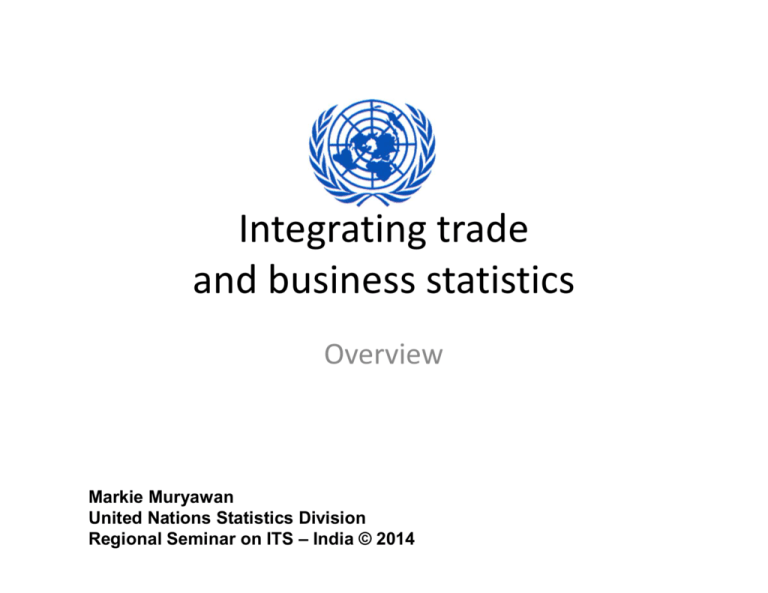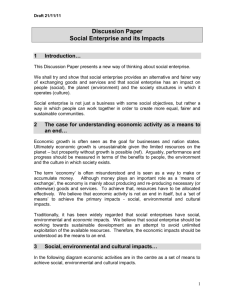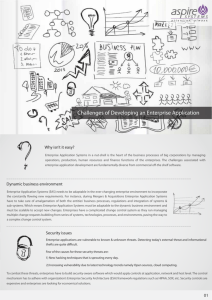Integrating trade and business statistics
advertisement

Integrating trade and business statistics Overview Markie Muryawan United Nations Statistics Division Regional Seminar on ITS – India © 2014 Linking trade and business statistics A. B. C. D. E. F. Background Trade vs. Business statistics Potential benefits and costs Possibilities and examples Trade by Enterprise Characteristics (TEC) Institutional arrangements 2 Background IMTS 2010: • Need for linking trade and business statistics (Para. 11.5): – In data compilation and analytical purposes – Prerequisite: National (Centralized) Statistical Business Register • Recommendation: Countries are encouraged to integrate their trade register with their business register and to take steps towards establishing an integrated system of economics statistics for data compilation and analysis. (Para. 11.6) Area of future development, moved from supplementary topic to main topic (TEC, Global Forum on Trade Statistics) 3 Background Statistical Commission • 37th session of the Statistical Commission in 2006: Endorsed the concept of an integrated approach to economic statistics and recommended its operational use in national economic programmes. • Statistical Commission report of 2008 – Conclusions (excerpts): The integration of economic statistics is about statistical reconciliation; […] it involves dealing with conceptual, statistical production and institutional issues. Institutional arrangements [...] are important for the management of integrated economic statistics and should be part of the corresponding reform programmes 4 Background Global Forum on Trade Statistics in 2011 Organized by UNSD and Eurostat in cooperation with WTO and UNCTAD in February 2011 in Geneva, as a follow-up to the 2010 Statistical Commission decisions on trade statistics. • Vision for the future of trade statistics Trade statisticians and policy makers agreed on a vision for the future of international trade statistics and called for the improvement of the relevance of international trade statistics by connecting trade information and integrating it with its economic, social, environmental and financial dimensions while minimizing the response burden, and to improve the statistical production process by better defining and organizing the co-operation among national stakeholders 5 Background Global Forum on Trade Statistics in 2011 (cont.) • Background note “International Trade Information System in 2020” (Informally) Endorsed by major international organizations active in trade statistics, it formulated 20 goals for trade statistics, including: Compilation: All transaction records (from customs or other sources) will contain an identification number of the importing or exporting enterprise that is linked with the national statistical business register; Additional information on trade collected via integrated business surveys; Dissemination: Joint release of statistics on trade in services and trade in goods, trade by enterprise characteristics, micro-data on trade in goods and services linked with other business information will be available in data warehouses to registered 6 users. Background Trade in value added (lead by OECD and WTO) Economic globalization leads to The needs of analyzing the global value chains Measure their impact on employment and economic development Methodology is converging to: Constructing and using global Supply-Use table or global Input-Output table Requirements: linking trade and SBR for national SupplyUse table; fully balanced bilateral trade matrix at global level; some characteristics of enterprises (foreign ownership, size, export intensity) 7 Trade vs. Business statistics • IMTS – International Merchandise Trade Statistics – Its goal is to describe bilateral flows of goods across countries – Value and quantity data, organized along well-defined dimensions (reporting country, partner country, commodity code, trade flow, reference period, mode of transport, etc.) – Main data source: customs records (with some exceptions) – There is no explicit statistical unit (other than the economic territories of the compiling/partner countries) – Highly standardized concepts and definitions • Consistency between customs and IMTS concepts and definitions • International comparability – Data collection at the most detailed level including trader information 8 Trade vs. Business statistics • Business Statistics – Its main goal is to provide information about the performance and the structure of businesses in an economy – Very broad and heterogeneous data set • Many indicators (e.g., sales, inventories, value added, employee compensation, employment, ...) • Diversity of users – Its basic statistical units are enterprises and establishments – Derived from multiple data sources (administrative records [such as business registers, tax records and social security records], business surveys, economic census) – Variety of concepts, classifications and levels of detail • Across different data sources • Across countries 9 Business register vs. Register of traders • Business register – Identifies the population of economically active enterprises for statistical purposes and their relationship with legal units for administrative purposes – Establishes and maintains links between different types of statistical units (e.g., between enterprises and establishments) • Register of traders (subset of Business Register) – Identifies enterprises engaged in international trade, mainly based on customs records or records from Ministry of Trade – Used mostly for IMTS compilation purposes, e.g.,: • Collection of trade data through surveys (i.e., price surveys of imports / exports) • Validation of customs records • Estimation of trade below statistical and customs thresholds 10 Matching and population identification methods • In practice, matching exercise is complex and can yield unexpected results – Conceptual differences: Enterprises registered on customs documentation are not necessarily relevant for statistical purposes (e.g., agents used by large and complex enterprises or types of statistical units are not properly defined) – Coverage: The business register often does not cover the whole population of importers and exporters, and needs to be updated – Coding errors: Invalid IDs and classification errors 11 Potential benefits and costs • Potential benefits: Additional and better statistical information for users (dissemination side) • About internationally active enterprises and their specific characteristics, such as size, sector of economic activity, geographic location, and level of concentration • About specific trade transactions, such goods for processing and intrafirm trade • For other statistical domains such as transport and environmental statistics • Business micro-data for analytical purposes, such as input-output analysis Improved statistical production process (compilation side) • Cost savings and efficiency gains, e.g. through survey coordination and reduction of response burden • Improved data quality, e.g., through consistency checks across different sources 12 Potential benefits and costs • Potential costs: Major investment in the development, implementation and maintenance of a national business register Integrating different statistics may require significant efforts Continuous updating requires significant efforts Requires setting up adequate institutional arrangements and overcoming legal obstacles, especially data sharing and exchange provision 13 Possibilities and examples • Example of Italy – Idea: Change from a product-based towards a business-oriented perspective in the compilation of trade statistics. – Core is business register: The link between the list of trade operators and the business register provides the gateway for developing an array of new outputs. – Outputs: depending on the level of integration achieved: 1. Trade statistics based on the number of trade operators by products and markets by linking trade-flow micro data with the list of trade operators, 2. Trade statistics based on the business characteristics of exporting and importing enterprises by linking and integrating the list of operators with the business register, 3. Integrated firm-level data warehouse by integrating a number of national surveys, foreign trade in goods, outward and inward multinational enterprise data and international databases 14 Possibilities and examples • OECD-Eurostat Trade By Enterprise Characteristics (TEC) database – Datasets are compiled by linking micro data (data at trader level) with business registers – Fixed set of enterprise-related indicators is generated and published at international level – At this time no flexible analysis or access to micro data. 15 Possibilities and examples • Example of Zambia – Conventional trade statistics cannot answer relevant policy questions (i.e., which industries depend on imports, participation of woman in trade, etc.) and no enough resources for enterprise or household surveys – Linking trade and business statistics allows CSO Zambia to answer those questions with no or low cost – Variables from trade (i.e., products, trading partner, etc.) and business registers (i.e., size, employment, economic activity, etc.) are now linked – The next step is to link the dataset with FDI, FATS databases at Bank of Zambia analysis on impact of globalization 16 Possibilities and examples (additional) – Integrating trade information in business statistics • Business statistics usually contain limited information on external trade – Special surveys on trading enterprises • Conduct surveys of specifically identified enterprises in order to obtain information on goods for processing, intra-firm trade, trade in services – Trade statistics as part of a geospatial information system. • Analysis of trade patterns by region, e.g., IBGE of Brazil publishes trade balance by state and municipality using the address of enterprises • Supplementing trade information with localized employment or tax information (i.e., average wages, employment rate, enterprise and personal tax revenue) allows a detailed analysis of regional economic impact of trade 17 Trade by Enterprise Characteristics (TEC) • New statistical domain • Aims at describing trade flows from the view point of enterprises: – Characteristics of importing/exporting enterprises – Involvement of different industries in international trade / global value chains – Involvement of small and medium enterprises in international trade / global value chains – Impact of international trade on employment, growth and income – Effectiveness of export-promotion policies – Etc… 18 Compiling Trade by Enterprise Characteristics (TEC) • Steps: 1. Define a common unit of analysis (e.g., “enterprise”), and the reference population and reference time period 2. Define a level detail for the analysis of linked data 3. Link the value of imports / exports of each importer / exporter with data on its characteristics from the business register 4. Compile and validate TEC indicators 5. Apply confidentiality rules / policy 19 Compiling Trade by Enterprise Characteristics (TEC) • The methodology must establish the reference population for the linked data, e.g.: – Value of linked imports / exports with respect to: • Total imports / exports • Total imports / exports above statistical threshold – Number of linked importers / exporters with respect to: • Total number of importers/exporters in the trade database • Total number of importers/exporters in the SBR • Total number of enterprises / establishments in the SBR 20 Compiling Trade by Enterprise Characteristics (TEC) • Some TEC indicators: – Trade by activity sector and enterprise size class – Concentration of trade by activity – Trade by partner countries and activity – Trade by number of partner countries and activity – Trade by commodity and activity –… 21 OECD-Eurostat TEC database 22 Institutional arrangements • Shared access business register and other data in compilation. In many countries more than one organization or agency is involved in trade and business statistics – information sharing needs to be allowed • Shared vision and commitment to integrating trade and business statistics. Concerned agencies and departments within agencies need to agree on the goal and vision for an integrated system of business and economic statistics, whose development and implementation require the commitment of significant human resources and the willingness to accept changes in existing practices • Clear policies on access to and use of confidential information. Business registers and data warehouses contain sensitive information about businesses. Issues of confidentiality and the protection of the highly sensitive business data need to be resolved. 23 Additional guidance in IMTS 2010 - CM Chapter 11: Integrating trade and business statistics A. Integrated approach to economic statistics B. The benefits of integrating trade and business statistics C. Integrating trade and business statistics in data compilation – possibilities and examples D. Ensuring quality of the linked data sources and the quality of the linked/integrated data E. Generation and dissemination of additional information – possibilities and examples F. Required institutional and working arrangements 24 Gradual Implementation Plan (learning from Italy experience) Advanced Core • Integrated firm-level data warehouse • Trade by Enterprise Characteristics Basic • Trade operators by products and markets 25 UNSD activities in SBRs • UNSD promotes creation and maintenance of National Statistical Business Registers as a core element in the implementation of integrated economic statistics • UNSD actively participates in various fora related to business register, such as Wiesbaden group or UNECE Task Force on SBR • UNSD supports implementation of linking trade and business statistics in countries (i.e., Costa Rica, Zambia, etc.) • UNSD contributes to other organizations’ initiatives in regards to SBRs 26 Thank you - Merci Please send your comments to muryawan@un.org







